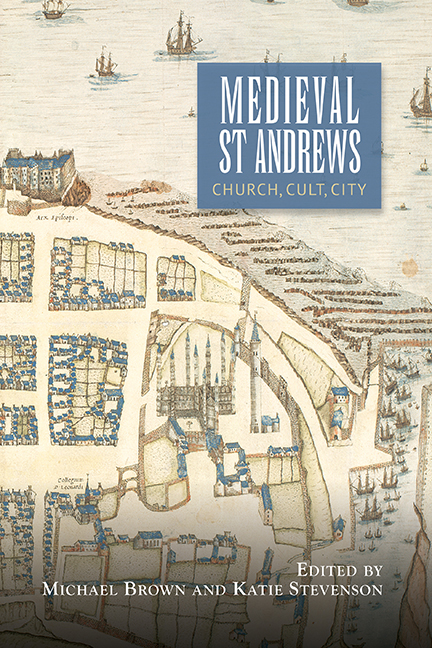Book contents
- Frontmatter
- Dedication
- Contents
- List of Illustrations, Charts and Tables
- Contributors
- Abbreviations
- 1 ‘Ancient Magnificence’: St Andrews in the Middle Ages: An Introduction
- 2 From Cinrigh Monai to Civitas Sancti Andree: A Star is Born
- 3 The Idea of St Andrews as the Second Rome Made Manifest
- 4 The Medieval Ecclesiastical Architecture of St Andrews as a Channel for the Introduction of New Ideas
- 5 When the Miracles Ceased: Shrine and Cult Management at St Andrews and Scottish Cathedrals in the Later Middle Ages
- 6 Religion, Ritual and the Rhythm of the Year in Later Medieval St Andrews
- 7 Living in the Late Medieval Town of St Andrews
- 8 The Burgh of St Andrews and its Inhabitants before the Wars of Independence
- 9 The Archaeology of Medieval St Andrews
- 10 Prelates, Citizens and Landed Folk: St Andrews as a Centre of Lordship in the Late Middle Ages
- 11 Augmenting Rentals: The Expansion of Church Property in St Andrews, c. 1400–1560
- 12 The Prehistory of the University of St Andrews
- 13 University, City and Society
- 14 The Medieval Maces of the University of St Andrews
- 15 Heresy, Inquisition and Late Medieval St Andrews
- Appendix 1 The St Andrews Foundation Account
- Appendix 2 The Augustinian' Account
- Appendix 3 The Boar' Raik
- Appendix 4 University of St Andrews Library, UYSL 110/6/4
- Index
- Miscellaneous Endmatter
9 - The Archaeology of Medieval St Andrews
Published online by Cambridge University Press: 28 April 2017
- Frontmatter
- Dedication
- Contents
- List of Illustrations, Charts and Tables
- Contributors
- Abbreviations
- 1 ‘Ancient Magnificence’: St Andrews in the Middle Ages: An Introduction
- 2 From Cinrigh Monai to Civitas Sancti Andree: A Star is Born
- 3 The Idea of St Andrews as the Second Rome Made Manifest
- 4 The Medieval Ecclesiastical Architecture of St Andrews as a Channel for the Introduction of New Ideas
- 5 When the Miracles Ceased: Shrine and Cult Management at St Andrews and Scottish Cathedrals in the Later Middle Ages
- 6 Religion, Ritual and the Rhythm of the Year in Later Medieval St Andrews
- 7 Living in the Late Medieval Town of St Andrews
- 8 The Burgh of St Andrews and its Inhabitants before the Wars of Independence
- 9 The Archaeology of Medieval St Andrews
- 10 Prelates, Citizens and Landed Folk: St Andrews as a Centre of Lordship in the Late Middle Ages
- 11 Augmenting Rentals: The Expansion of Church Property in St Andrews, c. 1400–1560
- 12 The Prehistory of the University of St Andrews
- 13 University, City and Society
- 14 The Medieval Maces of the University of St Andrews
- 15 Heresy, Inquisition and Late Medieval St Andrews
- Appendix 1 The St Andrews Foundation Account
- Appendix 2 The Augustinian' Account
- Appendix 3 The Boar' Raik
- Appendix 4 University of St Andrews Library, UYSL 110/6/4
- Index
- Miscellaneous Endmatter
Summary
IN the thirty-four years since the production of the St Andrews burgh survey, pressure from development has ensured that there have been several opportunities for archaeological investigations in the historic town. This chapter on the archaeology of St Andrews thus aims to provide an accessible synthesis of this fieldwork in conjunction with burgh survey material.
St Andrews is a fairly compact and self-contained town. The original settlement was situated between the Kinness Burn and the sea, and slowly, by stages, the town expanded westward. By the sixteenth century, St Andrews had reached the limits defined by ports at South Street, Market Street and North Street. These three streets dominate the town plan. The cathedral and its precinct serve as a focus for the street plan and the three main streets converge on the headland with only Market Street stopping before the cathedral is reached. These can clearly be identified on Geddy's map of c.1580, which also shows the beginnings of suburban development outside the town walls at the west end of South Street. St Andrews has so far largely escaped the attentions of massive redevelopment and as such still retains its medieval streetscape. The considerable number of archaeological projects that have been carried out both within and on the fringes of the medieval town have indicated that the chances of good survival of archaeological deposits and structures are fairly high.
For our purposes, the medieval burgh has been subdivided into six areas and there is a seventh area that includes the site of the Leper hospital. The boundaries between areas are based on street frontages and natural features wherever possible.
Area 1 Golf Place/Links Crescent/City Road/Market Street/Greyfriars Garden/Murray Park/West Sands
Area 2 Murray Park/Greyfriars Garden/Market Street/Church Street/ South Street/South Castle Street/North Castle Street/The Scores/Witch Lake
Area 3 Kennedy Gardens/Kinness Burn/Bridge Street/Alexandra Place/ City Road
Area 4 Market Street/Church Street/Queens Gardens/Kinness Burn/ Bridge Street/Alexandra Place
Area 5 South Street/Queens Gardens/Kinness Burn/Abbey Street
Area 6 North Castle Street/South Castle Street/Abbey Street/Abbey Walk/East Sands
Area 7 Kinness Burn/Woodburn Terrace/Arbitrary line to west of Priestden Place/Arbitrary line to south of Priestden Road/East Sands
The data recovered from St Andrews presents a vivid picture of a small medieval town on the east coast of Scotland. As with many archaeological excavations of a medieval date, in St Andrews ceramics tend to be the most common find.
- Type
- Chapter
- Information
- Medieval St AndrewsChurch, Cult, City, pp. 173 - 204Publisher: Boydell & BrewerPrint publication year: 2017

